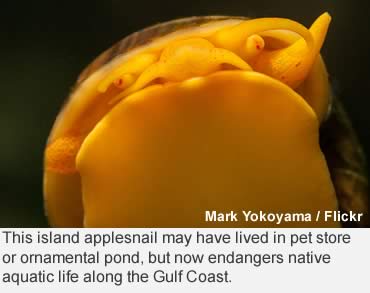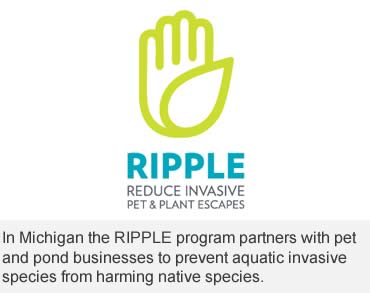Photo: Biologists hope aquarium and ornamental pond owners will learn about the unpredictable results of releasing exotic species.
It’s almost summer, time for a long vacation, and you want to clean up or empty the aquarium in the classroom or your home. Or, maybe the ornamental pond in your yard.
But what will you do about those aquatic plants and animals that have grown too large? They were a lot more manageable when they were small.
The first thing to know is that aquarium animals and plants should never be released into the wild. Or your back yard. Or the park or pond down the road.
In most places, releasing aquatic animals and plants is illegal because of the huge threat they pose to native species and ecosystems.
You might think that harmless-looking snail would do better outside, right? Or, it might die, naturally. No harm, no foul. Right?
Unfortunately, it doesn’t work that way. That aquarium snail can turn into a real menace.
 While the environmental damage caused by invasive species throughout the United States is devastating, the Alabama Department of Conservation and Natural Resources notes the Southeast is especially vulnerable due to its abundant biodiversity and aquatic habitat.
While the environmental damage caused by invasive species throughout the United States is devastating, the Alabama Department of Conservation and Natural Resources notes the Southeast is especially vulnerable due to its abundant biodiversity and aquatic habitat.
Biologists in other Southeastern states make similar observations, because they know when a nonnative animal or plant is introduced into an ecosystem, the results are often unpredictable.
In Michigan, one state with a Great Lakes shoreline, identical concerns are shared by RIPPLE (Reduce Invasive Pet and PLant Escapes), a partnership of Michigan State University Extension and the Michigan Department of Agriculture and Rural Development.
These scientists would like teachers and pet owners to be aware that releasing aquarium animals and plants in your local habitat can produce unpredictable results and create a devastating problem.
The national Aquatic Nuisance Species Task Force Strategic Plan indicates that “approximately 49 percent of imperiled species are endangered primarily because of predation or competition with exotic species.”
Exotic species are typically the type of aquatic animals sold at pet stores.
One exotic species, the Island Applesnail, appears as a growing threat, and was likely released into waters near Mobile Bay by an aquarium or ornamental pond owner.
Biologists in Alabama and Florida are concerned because these snails reduce the number of native aquatic plants necessary as food and habitat for birds and other aquatic organisms.
 Once an invasive organism becomes established, it is nearly impossible to eradicate.
Once an invasive organism becomes established, it is nearly impossible to eradicate.
In Florida, currently there is little the Fish and Wildlife Conservation Commission reports it can do to stem the exotic applesnail populations, as is the case for most established exotic species that are often part of the exotic pet trade.
But what to do about that aquarium and the critters in it you no longer want to keep?
Start by asking a pet store if they are willing to take unwanted aquarium animals or plants.
If a pet store will not take the aquarium animal, it will need to be euthanized. To properly dispose of aquarium animals and plants, they should be sealed in a plastic bag, frozen before being placed in the trash.
The U.S. Fish and Wildlife service lists the worst of the worst: zebra mussels, Chinese mitten crabs, hydrilla, Eurasian watermilfoil, nutria, sea lamprey, Asian carp, and New Zealand mudsnail. Learn more about invasive aquatic species and how they multiply here.
In Michigan, the RIPPLE campaign was created as a response to new aquatic species education. Learn about those efforts here.
Resources: Alabama Department of Conservation and Natural Resources, Florida Fish and Wildlife Commission, RIPPLE, Habitattitude—the ANS Task Force Partnership of the Pet Industry Joint Advisory Council, the U.S. Fish and Wildlife Service and NOAA Natural Sea Grant College Program, and Applesnail Net.